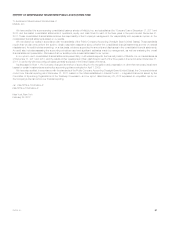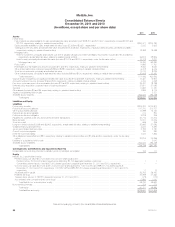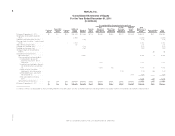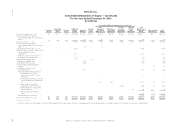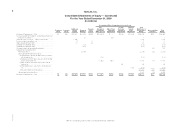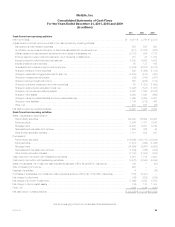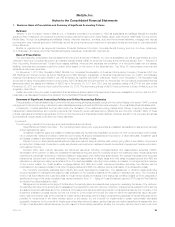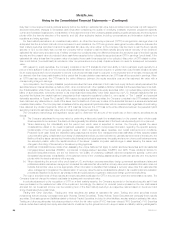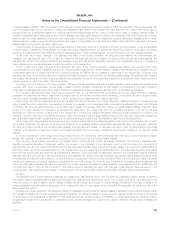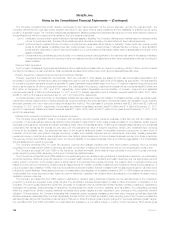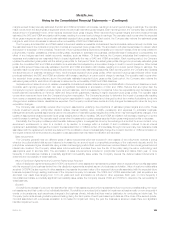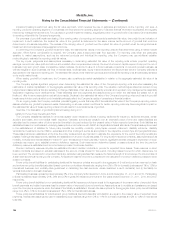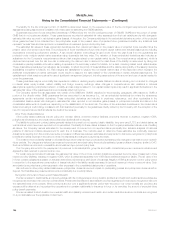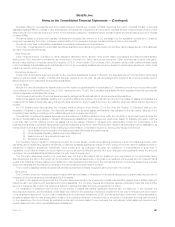MetLife 2011 Annual Report Download - page 101
Download and view the complete annual report
Please find page 101 of the 2011 MetLife annual report below. You can navigate through the pages in the report by either clicking on the pages listed below, or by using the keyword search tool below to find specific information within the annual report.MetLife, Inc.
Notes to the Consolidated Financial Statements — (Continued)
certain insurance products. FVO Securities also include contractholder-directed investments supporting unit-linked variable annuity type liabilities
which do not qualify for presentation and reporting as separate account summary total assets and liabilities. These investments are primarily
mutual funds and, to a lesser extent, fixed maturity and equity securities, short-term investments and cash and cash equivalents. The investment
returns on these investments inure to contractholders and are offset by a corresponding change in policyholder account balances (“PABs”)
through interest credited to policyholder account balances. Changes in estimated fair value of these securities subsequent to purchase are
included in net investment income, except for certain fixed maturity securities included in FVO Securities where changes are included in net
investment gains (losses). FVO Securities also include securities held by consolidated securitization entities (“CSEs”) with changes in estimated
fair value subsequent to consolidation included in net investment gains (losses). Interest and dividends related to all trading and other securities
are included in net investment income.
Securities Lending. Securities lending transactions, whereby blocks of securities, which are included in fixed maturity securities and short-
term investments, are loaned to third parties, are treated as financing arrangements and the associated liability is recorded at the amount of cash
received. At the inception of a loan, the Company obtains collateral, usually cash, in an amount generally equal to 102% of the estimated fair
value of the securities loaned and maintains it at a level greater than or equal to 100% for the duration of the loan. The Company monitors the
estimated fair value of the securities loaned on a daily basis with additional collateral obtained as necessary. Income and expenses associated
with securities lending transactions are reported as investment income and investment expense, respectively, within net investment income.
Mortgage Loans — Mortgage Loans Held-For-Investment. For the purposes of determining valuation allowances the Company
disaggregates its mortgage loan investments into three portfolio segments: commercial, agricultural, and residential. The accounting and
valuation allowance policies that are applicable to all portfolio segments are presented below, followed by the policies applicable to both
commercial and agricultural loans, which are very similar, as well as policies applicable to residential loans. Also included in mortgage loans
held-for-investment are commercial mortgage loans held by CSEs that were consolidated by the Company on January 1, 2010 upon the
adoption of new guidance. The FVO was elected for these commercial mortgage loans, and thus they are stated at estimated fair value with
changes in estimated fair value subsequent to consolidation recognized in net investment gains (losses).
Commercial, Agricultural and Residential Mortgage Loans — Mortgage loans held-for-investment are stated at unpaid principal balance,
adjusted for any unamortized premium or discount, deferred fees or expenses, and net of valuation allowances. Interest income is accrued
on the principal amount of the loan based on the loan’s contractual interest rate. Amortization of premiums and discounts is recorded using
the effective yield method. Interest income, amortization of premiums and discounts and prepayment fees are reported in net investment
income. Interest ceases to accrue when collection of interest is not considered probable and/or when interest or principal payments are past
due as follows: commercial — 60 days; and agricultural and residential — 90 days, unless, in the case of a residential loan, it is both well-
secured and in the process of collection. When a loan is placed on non-accrual status, uncollected past due interest is charged-off against
net investment income. Generally, the accrual of interest income resumes after all delinquent amounts are paid and management believes all
future principal and interest payments will be collected. Cash receipts on non-accruing loans are recorded in accordance with the loan
agreement as a reduction of principal and/or interest income. Charge-offs occur upon the realization of a credit loss, typically through
foreclosure or after a decision is made to sell a loan, or for residential loans when, after considering the individual consumer’s financial status,
management believes that uncollectability is other-than-temporary. Gain or loss upon charge-off is recorded, net of previously established
valuation allowances, in net investment gains (losses). Cash recoveries on principal amounts previously charged-off are generally recorded as
an increase to the valuation allowance, unless the valuation allowance adequately provides for expected credit losses; then the recovery is
recorded in net investment gains (losses). Gains and losses from sales of loans and increases or decreases to valuation allowances are
recorded in net investment gains (losses).
Mortgage loans are considered to be impaired when it is probable that, based upon current information and events, the Company will be
unable to collect all amounts due under the contractual terms of the loan agreement. Specific valuation allowances are established using the
same methodology for all three portfolio segments as the excess carrying value of a loan over either (i) the present value of expected future
cash flows discounted at the loan’s original effective interest rate, (ii) the estimated fair value of the loan’s underlying collateral if the loan is in
the process of foreclosure or otherwise collateral dependent, or (iii) the loan’s observable market price. A common evaluation framework is
used for establishing non-specific valuation allowances for all loan portfolio segments; however, a separate non-specific valuation allowance
is calculated and maintained for each loan portfolio segment that is based on inputs unique to each loan portfolio segment. Non-specific
valuation allowances are established for pools of loans with similar risk characteristics where a property-specific or market-specific risk has
not been identified, but for which the Company expects to incur a credit loss. These evaluations are based upon several loan portfolio
segment-specific factors, including the Company’s experience for loan losses, defaults and loss severity, and loss expectations for loans with
similar risk characteristics. These evaluations are revised as conditions change and new information becomes available.
For commercial and agricultural mortgage loans, the Company typically uses 10 years or more of historical experience in establishing
non-specific valuation allowances. For commercial mortgage loans, 20 years of historical experience is used which captures multiple
economic cycles. For evaluations of commercial mortgage loans, in addition to historical experience, management considers factors that
include the impact of a rapid change to the economy, which may not be reflected in the loan portfolio, and recent loss and recovery trend
experience as compared to historical loss and recovery experience. For agricultural mortgage loans, ten years of historical experience is used
which captures a full economic cycle. For evaluations of agricultural loans, in addition to historical experience, management considers factors
that include increased stress in certain sectors, which may be evidenced by higher delinquency rates, or a change in the number of higher
risk loans. For commercial and agricultural mortgage loans, on a quarterly basis, management incorporates the impact of these current
market events and conditions on historical experience in determining the non-specific valuation allowance established for each portfolio
segment level. For evaluations of residential mortgage loans, the key inputs of expected frequency and expected loss reflect current market
conditions, with expected frequency adjusted, when appropriate, for differences from market conditions and the Company’s experience.
Commercial and Agricultural Mortgage Loans — All commercial loans are reviewed on an ongoing basis which may include an analysis of
the property financial statements and rent roll, lease rollover analysis, property inspections, market analysis, estimated valuations of the
underlying collateral, loan-to-value ratios, debt service coverage ratios, and tenant creditworthiness. All agricultural loans are monitored on an
MetLife, Inc. 97


